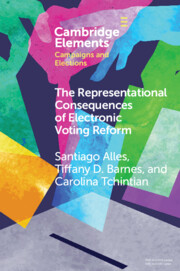Element contents
The Representational Consequences of Electronic Voting Reform
Published online by Cambridge University Press: 09 May 2023
Summary
Keywords
- Type
- Element
- Information
- Online ISBN: 9781108973960Publisher: Cambridge University PressPrint publication: 08 June 2023
References
- 7
- Cited by

